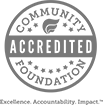Supporting Access for People with Autism
Sources disagree on the current prevalence of autism and disagree even more on what causes it. But one thing everyone involved with autism will tell you: more people than ever need support to manage the disorder — and that support is not easy to access.
“We’re seeing a tsunami of autism now,” said Dustin Watkins, Executive Director of Bittersweet Farms. “Some of this increase is due to a lack of awareness and understanding of the condition in the past — but it is also definitely increasing. Autism is a spectrum and families with people on the spectrum face all kinds of challenges, no matter where they are on that spectrum.”
But, thanks to the work of visionary leaders in the northwest Ohio autism community, the region affords youth and adults across this spectrum more support and connection than many U.S. cities its size, and those resources are growing. In this annual report, we showcase three innovating organizations that have received Greater Toledo Community Foundation support via family foundations, fundholder gifts and grants.
Bittersweet Farms
As understanding of autism grew throughout the 1970s, many area schools provided classroom education and other services for children whose autism required significant support. But when these children aged out of public education in their late teens, most faced a limited future with aging parents absent peer-group friends or meaningful work.
One special education teacher in Toledo Public Schools, Bettye Ruth Kay, dreamed of a better future for her students. In 1983, that dream became Bittersweet Farms.
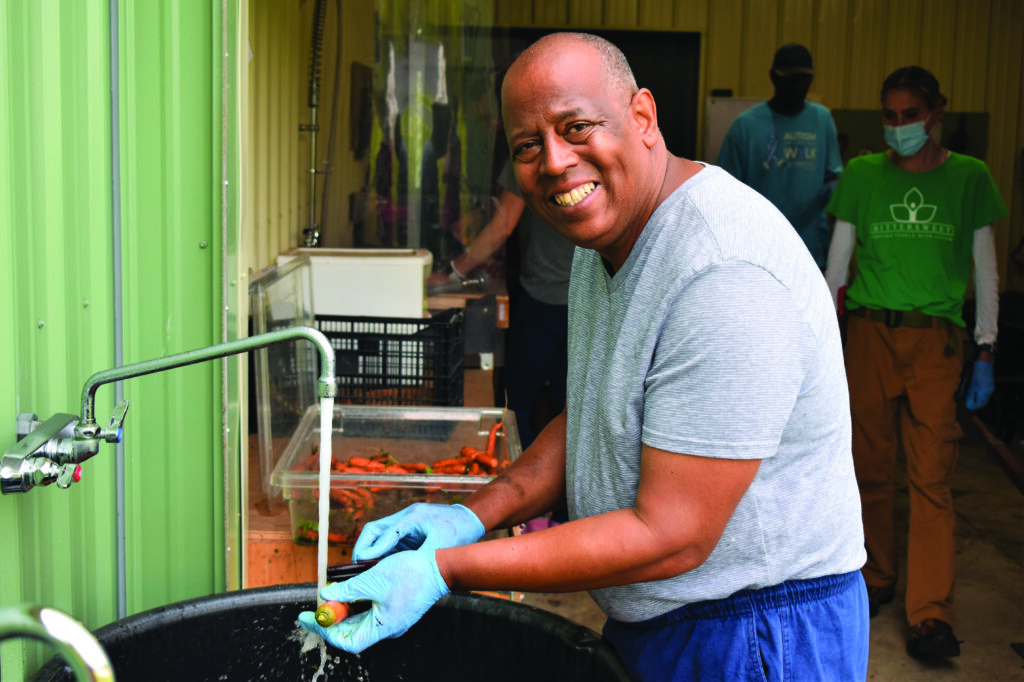
Modeling her vision on England’s Somerset Court, the world’s first farmstead community for adults with autism, Bettye began Bittersweet Farms with the help of area businesses and community members. Today, nearly 150 individuals are participating in day programs or living onsite at three different Bittersweet locations in Whitehouse, Lima and Pemberville — which still include some of Bettye’s students from the late 1970s.
Bittersweet’s focus on horticulture, animal care and creative arts reaps tangible benefits for program participants. “We could do more, but our workforce is the main limitation,” said Dustin, who joined Bittersweet’s support staff right out of college. “High behavioral needs require the highest grade of professional support because it is so much about rapport and relationships. It’s a real labor of passion — nobody gets into this kind of work because of the money. But we still have to be competitive to attract skilled professionals and offer quality programs that prospective employees recognize as making a difference.”
Bittersweet’s focus on horticulture, animal care and creative arts reaps tangible benefits for program participants. “We could do more, but our workforce is the main limitation,” said Dustin, who joined Bittersweet’s support staff right out of college. “High behavioral needs require the highest grade of professional support because it is so much about rapport and relationships. It’s a real labor of passion — nobody gets into this kind of work because of the money. But we still have to be competitive to attract skilled professionals and offer quality programs that prospective employees recognize as making a difference.”
Charitable donations are what make those programs possible. “The lion’s share of our funding comes from Medicaid — about 80-85%,” said Dustin. “Gifts from supporters make the crucial difference in the quality of our programs. Many of our core initiatives have been funded by Greater Toledo Community Foundation grants and gifts from donor advised funds.”
Avenues for Autism
When Bob and Suzy Tyner’s first child began exhibiting developmental abnormalities in the early 1950s, autism wasn’t even a word yet, let alone a diagnosis. But the Tyners were an exceptional couple. They relentlessly pursued the limited resources available at that time to help their son live his best life — and they had a vision for other families like them.
“In the 1950s and 60s, they were carving new trails,” said Dave Tyner, Bob and Suzy’s youngest son. “Dad’s original idea was ‘I want a building where people could go to get what they need.’ Mom and Dad knew that if they just had some information, they could have made a huge difference with their own son, and having blazed those trails, they felt they could make a difference for others.”
At first, the brick-and-mortar building of Bob’s dreams was out of reach — but eventually, the family started the Tyner Foundation in the late 1990s and began fundraising in earnest. In 2004, the Tyners established their foundation as a supporting organization with GTCF and the Great Lakes Center for Autism, which became Avenues for Autism in 2004, now housed in ProMedica’s Finnegan Center. Today, the Tyner Foundation is the primary source of non-Medicaid funds for the organization, and the Tyner family remains highly involved in both the fund’s and Avenues’ governing boards.
Mary Jane Luck, the Tyner’s daughter noted, “In a lot of ways, these parents have to reinvent the wheel. Where do you get information? Where do you get a diagnosis — and how do you get in line for one, which itself can take some time? And once you do, it’s not a one-size-fits all as far as therapies go. Avenues for Autism streamlines this process for families.”
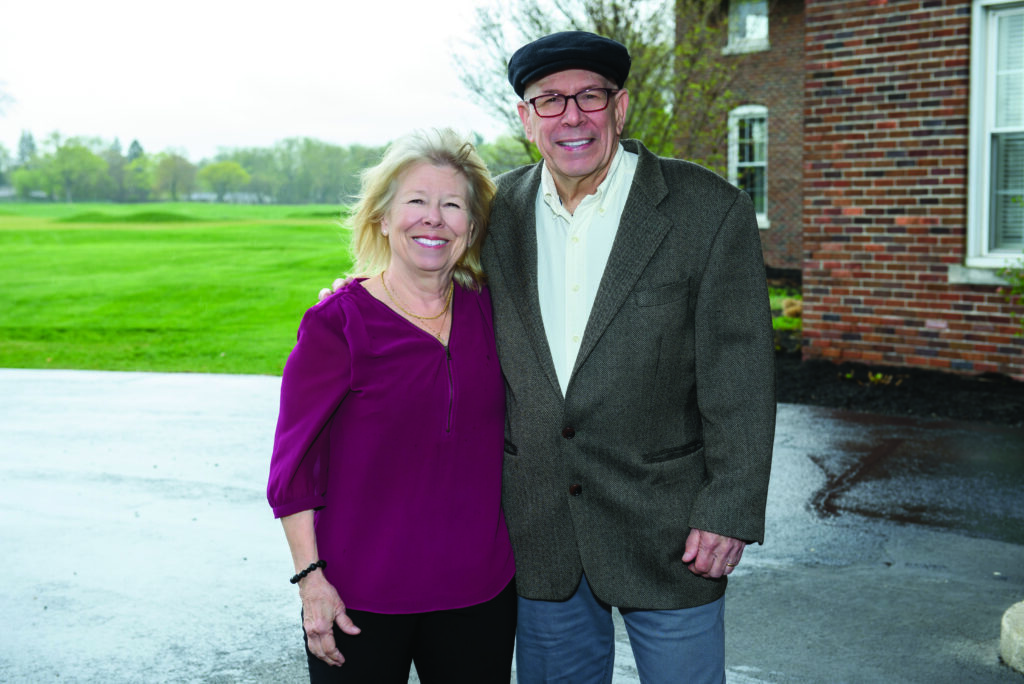
Avenues’ executive director, Stacy Harper agrees. “No two situations are the same for families with autism, and everyone’s journey is different,” she said. “Avenues is a place where families can get help, in person or online, with navigating our many area resources to find those that best fit their needs. We also provide highly trained therapists who work with caregivers as well as those on the spectrum.”
Many such families have needs that aren’t paid for by Medicaid — so the Suzanne Tyner Autism Fund was created specifically to meet these needs. Stacy gave an example: “An area family had a child who could not tolerate the tactile stimulation of a shower. They didn’t have a bathtub and couldn’t afford to pay for one. A grant from this fund covered the cost of a tub and its installation, so the child could bathe comfortably.” In 2022, this fund provided roughly $45,000 to more than 30 families for medical and social services, therapies, sensory items, tuition, safety equipment and more.
Bob and Suzy have now passed, and their legacy is being maintained by Dave and Mary Jane, with Dave’s two sons now involved as well. “GTCF has been a huge factor in the growth of Avenues for Autism” said Dave, noting that because he and Mary Jane both live out of town, GTCF’s local business connections and guidance have been as important to them as GTCF’s management of the Tyner Foundation’s funds. He concluded: “In our early days, when it was mainly fundraising, our resources were a total pass-through. Now, as a supporting organization, our foundation can provide a certain amount in perpetuity to Avenues — and more than 90% of the money goes directly to families to pay for services or other needs.”
Valentine Theatre
Thanks to the efforts of Destination Toledo, The Ability Center and several area tourism attractions, Toledo is on its way to becoming a Certified Autism Destination city for families nationwide.
The Valentine Theatre is now among these attractions — but this wasn’t the initial goal of the Valentine staff when they began exploring autism-friendly programming for children.
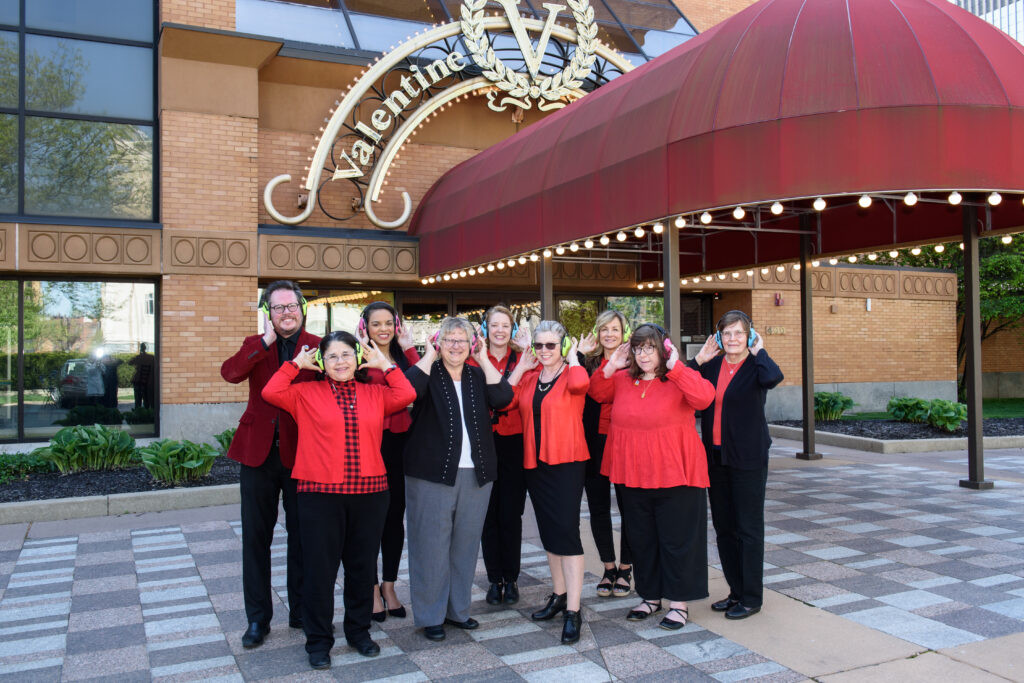
“Our Executive Director, Jori Jex, had nominated me to be a panelist on the Ohio Arts Council sustainability grant,” said Valentine Development and VSD Coordinator Kelby Sodeman, describing her experience in Columbus. “One of the presentations that stood out to me was a New Albany Symphony program for children with autism called ‘Sensory Saturdays.’ It made me realize there were whole populations that were missing out on what we had to offer.”
Valentine’s leadership was enthusiastic about Kelby’s report and the possibilities of creating special programming for children with autism. On the advice of former Executive Director of Avenues for Autism Katina Harding, the Valentine created a “retreat space” adjacent to the front lobby where audience members who needed a stimulation break could go during a performance.
Another essential key to an autism-friendly experience was high-quality training for [#] of their all-volunteer team of ushers. Suitable programming designed for youngsters with autism was another need. Jori explained how GTCF made both possible: “GTCF had a community builder grant in two amounts — $50,000 and $25,000. Our application for the smaller grant was approved and allowed us to pay for staff and volunteer training. It also covered resources for visitors like headsets and fidget toys and the programming itself, so we could avoid taking on a heavy financial risk as we implemented the program.”
Kelby added: “The national touring groups who present our children’s theatre were already offering sensory-friendly adaptations of their programs. So, even though there were modifications to the experience, all of our usual families came anyway — they didn’t feel like it wasn’t for them.”
GTCF-funded staff and volunteer training also earned the Valentine a Certified Autism CenterTM (CAC) designation. The certification is granted by the International Board of Credentialing and Continuing Education Standards (IBCCES), and supports the effort to make Toledo the second autism-friendly destination city in the U.S.
But it’s the joy of children who’ve been introduced to the experience of live theatre of which the Valentine team is most proud.
“We had tons and tons of compliments!” said Kelby. “For our very first show, I stood where our usual will-call table was to distribute headsets and fidget toys, just letting people know what we were doing. People would say, ‘I have a friend whose child has autism — I’m going to let them know about this!’ Most families like this have never been able to take their child to live theatre for fear their child might be too disruptive or that they might be ‘shushed’ or made to feel uncomfortable. Our mission was to make the Valentine a warm and accommodating place for children with autism and their families to make memories together.”
A “disconnected entrepreneur” might sound like someone running a company that isn’t tapped into what’s happening around them. And in a way, that’s true – but not the way you might suppose.
“Disconnected entrepreneurs” are those who have historically lacked access to the three essentials of successful businesses — capital, services and connections. Black-, Latinx- and women-owned businesses often find themselves without these three essentials and, as a result, may struggle to succeed.
Connecting our region’s enterprising but under-resourced business owners with these critical resources was the goal of Greater Toledo Community Foundation’s multi-year grants to JumpStart.
ESP provides insights for young companies
JumpStart had its beginnings 20 years ago in Cleveland as a venture to support tech startups in northeast Ohio. Backed by both state and community support — including major grants from the Ohio Department of Development (ODOD) and KeyBank — JumpStart leads the ODOD’s Entrepreneurial Services Provider (ESP) program across Northern Ohio.
Its success with the ESP in Northeast Ohio made it the ideal organization to step into the gap in 2018, when a new leader was sought for northwest Ohio’s ESP, NextTech. Partnering with ProMedica and other organizations, JumpStart opened an office in Toledo and began leading the ESP in Northern Ohio.
Over time, JumpStart also became highly experienced in serving disconnected entrepreneurs.
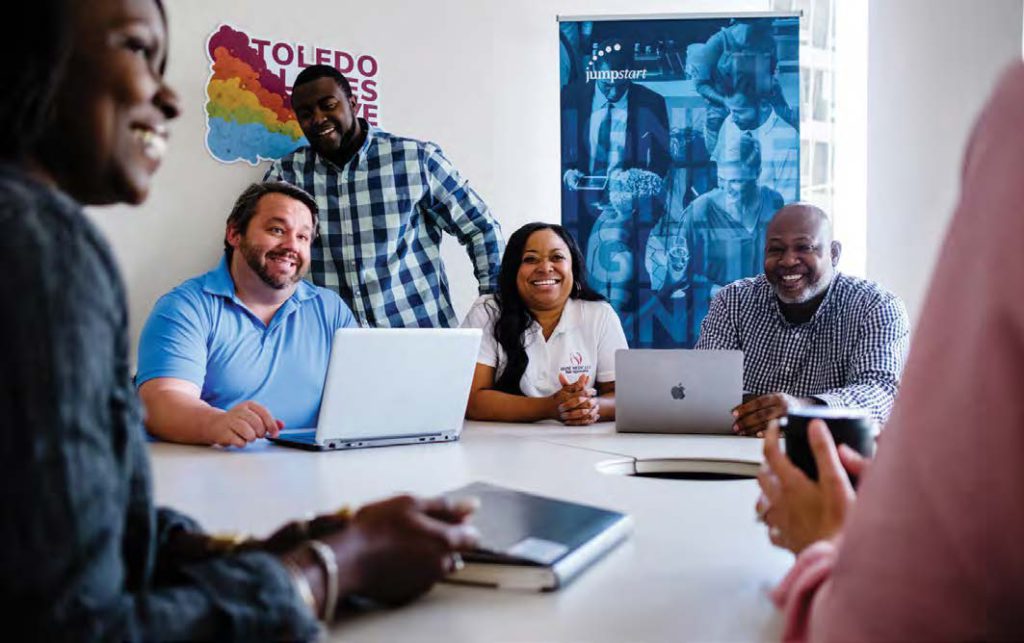
“We are not exclusively a minority business accelerator,” explained Amy Haschak, JumpStart’s director of Toledo operations, “but a lot of our work bridges that gap.” She added, “Our mission is to unlock the potential of entrepreneurship to transform entire communities. We find that some communities have more challenges than others — so making sure that everyone has access to resources is a JumpStart priority.”
GTCF and BGC partner for capital, services and connection
An initial Community Funds Impact grant from GTCF provided funds to support JumpStart’s work, including its centerpiece program, the Business Growth Collaborative (BGC). Convened and facilitated by JumpStart, the BGC currently comprises 12 independent nonprofits with a history of well-proven programming for business owners. The collaborative supports entrepreneurs in varying essential ways — including operational and technical support, financing and mentoring.
Addressing a shortage of mentors for disconnected entrepreneurs was a particular focus for the BGC. The GTCF Community Funds Impact grant, which extended over four years and helped to seed the BGC’s mentoring program, was key to attracting skilled participants. The initial outcomes were so successful, GTCF also awarded JumpStart a grant through the Equity and Access Initiative Fund. The additional award provided capital for minority owned businesses and entrepreneurs along with ongoing support for a relationship manager at a BGC member organization who focuses on diversity, equity and inclusion matters for clients.
GTCF’s Vice President of Community Investments, Patrick Johnston, explained: “Connecting area nonprofits for greater efficacy is a major focus of the Foundation. The goal of the BGC was to bring together existing groups with well-proven track records to help them be more efficient. It was an ideal fit.”
Amy described the game-changing role of the BGC: “It’s not uncommon for organizations to work alongside each other and make referrals, but then they don’t know what happens after that. The Business Growth Collaborative comes together in a more sophisticated way, with monthly meetings to discuss clients that need assistance and referrals.” The BGC also structures their client support by establishing milestones and tracking their clients’ progress toward those goals.
Education plays a vital role
Structured training is also key to JumpStart’s success model. “We do Value Proposition and Market Validation workshops for very early-stage businesses,” said Amy. “These provide a firm foundation for new entrepreneurs while also identifying business ideas that are not well thought-out or involve entry into an already saturated market.” Other programs available through JumpStart include one-on-one advising and a multi-week “Blueprint” program for start-up planning.
JumpStart clients with established businesses that meet a revenue threshold and other criteria can participate in their Impact program, a 12-week intensive limited to five businesses per cohort. Impact participants meet weekly with two advisors, a JumpStart staff member, and a volunteer from the community. At the end of the program, cohort members do a pitch showcase in front of judges from the community. “The top pitch is awarded $10,000 to support their business; the rest get $2,500,” said Amy, “so they are literally paid to enter the program. These and other JumpStart investments in entrepreneurs pay handsome dividends in terms of area business growth, employment and tax revenues,” she added.
State funding leverages donor dollars
JumpStart’s Communication Director, Vicki McDonald, noted that their funding structure provided even greater opportunity for impact. “Our grant from the state of Ohio has to be matched dollar for dollar,” she said. “So, to receive funds, we must raise the equivalent funds, giving us the unique ability to leverage our financial contributions.”
“We also wouldn’t have gotten as far as we have without our volunteers,” she added. “There are many exciting ways to support area entrepreneurs through JumpStart and make a deep economic impact on the community.”
As one of the Toledo area’s leading family-focused community agencies, the YMCA of Greater Toledo has had a long relationship with Greater Toledo Community Foundation. When the COVID-19 pandemic upended the lives of so many served by the Y, the established partnership became more important than ever.
Rewriting the script for childcare
“GTCF had been helping support our early childhood programs that serve infants, toddlers and preschoolers by enabling us to improve teaching practices and program quality, as well as hiring a teacher mentor to implement curriculum programs,” said Lesley Doria, YMCA Vice President of Child Care. “The whole culture in our early childhood programs had changed in a positive direction.”
She continued, “It’s well-known that more than 60% of children entering kindergarten in Ohio are not ready to learn. Our goal was to have every child kindergarten-ready, and pre-COVID we had been making tremendous progress. We had more than 20 centers serving 1300 to 1500 kids each day from 10 area school districts, with about 86% of kids in our programs at ready-to-learn levels.”
Then on March 25, all early childcare centers were ordered to close — and the Y’s forward momentum suddenly halted. “We received pandemic licensing but maintaining capacity to re-open was a challenge. We had to change health and safety practices as well as cleaning procedures and spent a lot of time and expense to make those work,” said Lesley. “At first, we were able to keep only four centers open and could accept only about 200 youngsters from families of essential workers.”
Pre-pandemic, the Y was also working inside elementary schools, providing wrap-around before- and after-school care — and again, the Y adapted. “We worked directly with school districts in the past, so we were an entity the schools could lean on for support,” said Lesley. “We transitioned our early childcare stand-alone services to accommodate working families with school-aged kids who needed daytime supervision.”
Lesley observed that GTCF funding was vital to sustaining the YMCA’S childcare activities during the peak months of the pandemic. “Some of the funds helped us provide staff to facilitate virtual learning. Kids needed a lot of help with that, especially at the very beginning,” she noted.
“And, about 50% of our kids are on some kind of assistance, such as state funds or YMCA scholarships, and paid by attendance, rather than enrollment. This was tough because student attendance was very inconsistent,” she explained. “The other 50% of families couldn’t budget for kids to be out of school the entire time. Going from $60 or $80 a week for part-time to $140 for full-time is a big jump up. GTCF funding allowed us to expand services to kids without passing costs along to families.”

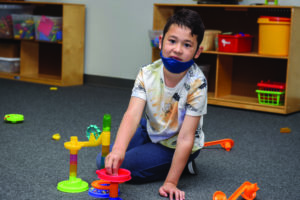
Feeding the newly hungry
When many formerly self-sufficient families found themselves under financial stress, GTCF funding also supported expanded food distribution and hot meals for families at various YMCA facilities across the region.
Beth Deakins, YMCA’s Director of Healthy Living, explained the Y’s role of distribution in a collaborative effort to provide meals to families in need. “We work with Summer Meal Partners, a group that provides kids with food when school is not in session, Connecting Kids to Meals, and A Village on Adams / Manhattan’s Catering, both of which provide the bulk of meals for children in after-school programs, sports programs that feed participating kids, and YMCA sites,” she said.
With pandemic restrictions in place, the Y and their partners no longer could provide the in-person, family-meal experiences that were their norm. But hot meals that families could enjoy together was still the focus. And, with the GTCF grant, the program expanded from one to three meals a day — so when parents came to pick up lunches, they would also get something for dinner and breakfast for the following day.
“We saw the same faces and families over and over,” said Beth. “They told us that sharing breakfast, lunch and dinner together when the parents were unable to work made a big difference. Because of the GTCF funding we received, we built new relationships with families that typically wouldn’t have needed assistance.
“In some cases, families weren’t even really able to cook,” Beth added. “One of the barriers we consistently saw were families that didn’t even have the means to cook — like a working stove or oven, or pots and pans — or families who had the utilities turned off because they were unable to pay the bills. The hot meals that the Y was able to provide helped parents fill the gap even though they didn’t personally have the means to make that happen.”


GTCF grant supports sustained service
“When it was announced that schools were going to go remote and food access at schools would no longer be available to them, the Y network pulled together to ask, ‘What are the locations where we could start something immediately?’” said Beth. Right away, Wayman Palmer and Eastern Community Y, serving Oregon & East Toledo residents, were added, as were the West Toledo and Wolf Creek locations a few weeks later, with Panera as an additional meal-prep supporter.
“GTCF funding came through quickly, and the actual dollars lasted us through October. But, because of the funding we got, we were able to put some things in place to help us sustain the programs,” said Beth. “Food insecurity issues are not going away. Food access has been an issue in our community for some time, and the GTCF grant has provided resources to building systems and structures that will help address these issues going forward.”
Beth also acknowledged the service of countless volunteers, some of whom were actually furloughed YMCA employees and older community members who were among the most at risk of contracting COVID-19. “It’s passion work,” she noted. “The strength of relationship and collaboration in Toledo really pushed us ahead in the pandemic and gave us an opportunity to build people up at a time when things were crumbling beneath us.” Added Lesley, “Shifting our programs to meet shifting needs was how we kept going.”
Be brave enough to start a conversation that matters.
— Margaret Wheatley
Two years ago, two Toledo arts organizations had a conversation. No one knew at the outset that it would matter quite as much as it did. But at its conclusion, a unique model was created that combined the symphony and ballet — the Toledo Alliance for the Performing Arts — and a new era had begun for both music and dance in Toledo.

At first, the conversation was about finances, explained Zak Vassar, president of the Toledo Symphony Orchestra (TSO).
“For decades, members of the TSO had comprised the pit orchestra for the Toledo Ballet, most notably for their annual performance of The Nutcracker,” he said. “But in recent years, the Ballet had begun to experience some financial pressures and asked the TSO if they could reduce their price for the annual performances of the holiday classic.
“Members of the Symphony are paid contractually established rates, so our cost was not something we could change,” he continued. “But we wanted to assist. So, we offered to help them sell more tickets to the performances.” TSO proposed setting a target beyond which all receipts would be split 50/50, and the Ballet agreed.
Photo: TAPA's combined performance of Carmina Burana, Feb. 14, 2020
With their well-established promotional channels, TSO’s involvement lead to a 24% increase in box-office revenues for The Nutcracker that season. Describing a post-event review meeting, Zak said, “We asked: Should we do this again? To which the then-chair of the Ballet board, Stephanie Alexander, replied, ‘Let’s do this forever.’”
Enter GTCF and the Strategic Alliance Partnership (SAP).
“We knew a facilitated discussion would be essential to a successful process,” said Zak. “The facilitator would need to be a skilled professional with extensive experience in the arts. We also knew about the GTCF’s Strategic Alliance Partnership and how the SAP grant could assist with the cost of our facilitator.”
Heather Bradley, director of The Center for Nonprofit Resources and SAP Program Officer, described the role of the SAP grant in the process. “SAP grants support collaborations of all types between nonprofits that operate in similar arenas,” she said. “One example of SAP support is engaging a neutral third-party professional who can help participants identify a sustainable business model.”
She continued, “This is the one GTCF grant that involves a two-step process. We received a letter of inquiry, which was then reviewed by all three SAP investment partners — GTCF, Stranahan Foundation and ProMedica,” she explained. The fund partners agreed on the merits of the collaboration and invited the participants, who by then had grown to include the Toledo Opera, to submit a proposal.
A real conversation always contains an invitation … to tell you who they are or what they want.
— David Whyte
With the grant in place, the group secured La Piana Consulting to facilitate the discussions. “La Piana came to the table with an early clarification of what would come from this,” said Zak, “ranging from nothing at all, up to and including shared participation, marketing, box-office sales or a total merger.”
While the initial vision was music, song and dance, the Opera chose to remain independent in the end. “The generosity of the GTCF funding provided the space to express with candor both our hopes and our fears,” observed Zak. “The facilitator allowed us to investigate our potentials, choose what’s best for each and still leave the process as friends.”
Zak pointed to another dynamic involving the remaining two groups. “We can’t say that we came to the table as equal organizations,” he said. “The Ballet relied quite a bit on parental and community volunteers. Its dancers were pre-professional youth, occasionally joined by hired adult performers. In contrast, the Symphony had a robust staff, professional union musicians and a $7 million budget. But,” he paused to note, “our attitude was that we were two equals coming together.”
Conversation is a catalyst for innovation.
— John Seely Brown
“The discussion also improved our vision of what we could accomplish creatively,” Zak added. “The visual experience of the symphony is quite static, so the opportunity to expand dance into the orchestral space, making movement a part of the audience experience, was huge.” The process concluded in a decision to form a new organization, TAPA, which would handle administration for both the Symphony and Ballet and facilitate their creative collaboration.
The new structure resulted in immediate operational efficiencies. The Ballet had several unresolved vacancies that TAPA made unnecessary to fill. Their executive director joined the Symphony, which in turn afforded the Ballet all the benefits of its fundraising and marketing infrastructure. But there were still concerns to be resolved.
“When we thought about the branding implication of the merger, the biggest question I had was: ‘How do we answer the phone?’” said Zak. “We had to change our names on everything. This is a functional and marketing issue — but it’s also an organizational culture issue.”
He explained: “Donors have such a significant investment in the mission and people of each organization that if we say, ‘give to TAPA,’ we have erased the emotional ties to the legacy organizations. We had to address that concern, too.” So, for now, the TAPA business cards have on the back both TSO and Ballet logos, and the two organizations maintain separate annual fundraising efforts.
Even with these concerns, it is evident to all involved that the benefits of collaboration are outweighing the potential challenges. Zak concluded, “For me, the most exhilarating thing about the merger was what happened in the community after the two organizations raised their hands and said, ‘Let’s collaborate.’ It’s truly a multi-genre experiment to grow the appetite for both music and dance in this region. Our recent performance of Carmina Burana was an example of this, and one that I couldn’t be prouder of.”
The Strategic Alliance Partnership was created to support the exploration and formation of collaborations, alliances and/or mergers that would enable area nonprofits to achieve more effective and efficient use of financial and human resources, gain greater long-term financial stability and enhance social impact. If your nonprofit seeks to benefit from such a partnership, please contact Heather Bradley at [email protected].
SAP Grants
Learn more about Strategic Alliance Partnership (SAP) grants offered through Greater Toledo Community Foundation.
Discover SAP grants!A Community Joins Forces to Battle Human Trafficking
Two decades ago, victims of human trafficking in northwest Ohio — and indeed, in most of the nation — faced bleak prospects. Labeled as criminals, they had little hope of escaping those who exploited them, as their alternative to slavery was usually imprisonment.
In the late ‘90s, as the public began to better understand the real nature of human trafficking, the criminal justice system likewise began to change its approach, and area social service agencies got involved. But while the goals were admirable, the shadowy nature of human trafficking made it hard to identify those in need, and the various groups working on their behalf were not well coordinated.
To improve the situation in northwest Ohio, stakeholders came together to form the Lucas County Human Trafficking Coalition (LCHTC). It brought together key partners in law enforcement, health care, social services agencies, and education to improve prosecution of traffickers and assistance to their victims. But process issues still persisted.
Enter PATH
“PATH — Partners Against Trafficking in Humans — Is both a network and a methodology,” explained Chris Dziad, program officer for the Toledo Community Foundation. “The network includes more than 60 area agencies and individuals who work with victims of human trafficking on everything from legal services to housing to job training and placement. PATH’s methodology is to find victims of human trafficking, link them with services, and use data from those services to improve outcomes.”
PATH was the product of collaboration between the LCHTC and Dr. Celia Williamson, director of UT’s Human Trafficking Institute, and PATH Coordinator, Fanell Williams. “I had been serving as an evaluator of a program called Pathways, developed in Mansfield, Ohio by Dr. Sarah Redding,” said Williamson. “Pathways was incredibly successful in improving outcomes for low-birth-weight babies. I saw that it could be applied to the human trafficking issue with similar results.”
Data-driven feedback improves outcomes
“What’s different about PATH is the academic component,” explains Brett Loney, UT Foundation Associate Vice President of Central Development, who brought the project to TCF’s attention. “UT’s Human Trafficking Institute provides both teaching and research to analyze and improve outcomes.”
Commenting on the Institute’s role in PATH, Dr. Williamson explained, “The Pathways model that we adapted involved the use of a ‘hub’ that served both as a resource for connecting victims to services, and for gathering data from those services.
“With the data collected from those agencies,” she continued, “we can identify the interventions that work and those that don’t. Our leadership subcommittees then work with those findings to break down barriers and improve our processes. That allows us to direct community resources accordingly.”
In the local PATH model, the Hospital Council of Northwest Ohio houses and manages the PATH hub. Said Dziad, “The Council was already involved with the low-birth-weight project, and so PATH was a natural fit for them. Their collaboration is an essential part of the process.”
PATH also has a mission-critical training component that was Dr. Williamson’s innovation. “To succeed, we must first prepare the community,” said Williamson. “Upon joining PATH, all participating agencies receive training in human trafficking issues, trauma-informed care, and the PATH model – so we are all on the same page.”
A well-conceived plan opens funding doors
When PATH needed startup funding, Loney thought it might be a fit for the Toledo Community Foundation.
“When I first learned of PATH, I thought it fit the Toledo Community Foundation way of doing things,” said Loney. “It involved community collaboration with established participants who had proven track records, and it was well-visioned.”
Loney also noted that PATH had already obtained both private and public grants, and had excellent prospects for continued funding once the program was established. “The evidence-based approach of this program is very attractive to supporters,” he added.
Chris Dziad agreed. “Human trafficking was an issue the Toledo Community Foundation had established a decade ago as a priority,” she said. “So, when the UT Foundation approached us about PATH, we were thrilled.
“We could see it had all the characteristics we look for in a funding opportunity,” she continued, “and UT’s commitment of support meant they had both stability and strong potential to win large grants from major funders to sustain their work.”
“We could see it had all the characteristics we look for in a funding opportunity and UT’s commitment of support meant they had both stability and strong potential to win large grants from major funders to sustain their work.”
_ CHRIS DZIAD
Stability for PATH’s clients and a safer, healthier community is the ultimate goal of everyone involved with PATH. “We don’t just want victims to survive. Our goal is to move them from victim to survivor to THRIVER,” said Dr. Williamson. “I never once met a victim who didn’t want a better life,” she added. “We can make that happen.”
No more "throwaway people"
The story of PATH begins more than two decades ago with one remarkably determined individual, UT professor Dr. Celia Williamson, and her conviction that a broken system not only could be repaired, but could be completely reconceived.
“Back in the early ‘90s, I was just going to be a social worker helping women and kids in Toledo’s North End, and then retire,” mused Dr. Williamson, reflecting on her early career goals. “Human trafficking victims were not my focus. Initially, I just wanted them off the streets and not troubling ‘my kids.’
“But then I started to realize that these women were actually victims,” she said. “And where was the help for them? There wasn’t any – because we treat these women as ‘throwaway people.’ We think, ‘I’m going to help someone who DESERVES help,’ and we pass them by. I couldn’t just let that happen.”
Creating a "go-to" place for victims
Williamson recognized at the outset that before she tried to solve the problem, she needed to understand it — and so her first step was research. After six months of interviewing victims in Toledo’s north end, she formed her first program to serve trafficked women, named by the women themselves as Second Chance. “Second Chance (now known as RISE) soon got a reputation as being the place to go for anyone having trouble with ‘the system.’ Even insiders like police and health care workers got involved,” said Williamson.
Reframing the discussion
Knowing that the public felt such women didn’t “deserve” help, another of Celia’s goals was to reframe the discussion surrounding trafficking victims. “I worked closely with The Blade to connect reporters to stories they wouldn’t have otherwise been able to tell – and in so doing, we were able to heighten public awareness and shift public opinion,” she recalled. “I also did a LOT of presentations to area churches. Our first grant for Second Chance came from the United Methodist Church as a result of one of those presentations,” she noted.
When the U.S. Congress passed the Federal Trafficking Victims Protection Act in 2000, the problem was finally redefined legally. “We didn’t even use the term ‘human trafficking’ originally,” said Williamson. “With the passage of that law, anyone under 18 engaging in prostitution was automatically defined as a victim, as was anyone who was under force, fraud or coercion. Calling this ‘commercial sexual exploitation’ completely changed the discussion.”
Developing a global network of experts
The year 2000 saw another important goal completed for Dr. Williamson: she finished her PhD at Indiana University and accepted a position on the faculty at The University of Toledo. “I knew my research opportunities were here because I already had an established network of people in the tough communities I had served in the past – so doors would open here.”
And open they did. With her new duties of teaching and research, Williamson turned over Second Chance to its well-mentored staff and turned her attention to overcoming the next major barrier in human trafficking: communication.
“People in the field weren’t sharing what was working and what wasn’t – we needed a conference. So I decided to host one.” she said. Now in its 14th year, the annual Human Trafficking and Social Justice Conference attracts more than 1500 attendees to the UT campus each year, and has greatly expanded both awareness and understanding of human trafficking.
Establishing UT's Human Trafficking Institute
As UT’s thought leadership in the field of human trafficking grew, University leadership recognized the need for a greater commitment to support that work. And in 2014, UT’s governing board voted unanimously to create the Human Trafficking Institute at UT, one of the first of its kind worldwide.
The Institute’s mission is to expand knowledge about human trafficking and to establish best practices in the field of human trafficking intervention. Its ongoing partnership with the UT Foundation was an important factor in the establishment of PATH.
“The UT Foundation was a tremendous asset to the Institute. It’s been a wonderful partnership,” she said. “Together, we’ve identified objectives and priorities; drafted case statements, opened doors, and started the conversations that have led to real change in the community.”

Ninety-five years ago, Toledo’s “wayward women” were housed in the local jail. Seeing that these women were more victims than perpitrators, Helen Beach, the wife of Toledo’s legendary Mayor, Golden Rule Jones, gave her home to create what is now the Beach House Family Shelter.
In 1982, ten area churches that were working separately to help the homeless recognized their work would be much more effective if they joined forces, and created FOCUS — Family Outreach Church-Community United Services.
And in 2009, the United States Congress enacted new legislation that dramatically affected both organizations. This is the story of how, with the support of Toledo Community Foundation, these two established, successful nonprofits merged to respond to changing needs, and in so doing, became stronger together.
When the U.S. government created the Federal Strategic Plan to Prevent and End Homelessness seven years ago, it effectively ended one-to-one government reimbursements to nonprofit agencies for services rendered to the homeless. Instead, those payments would now be based on the performance of the entire community in meeting government goals for addressing homelessness and its causes.
The core of this plan was an approach called rapid re-housing. This replaced indefinite stays in homeless shelters with a mandate that communities place the homeless in transitional housing within 72 hours, and connect them with support services to address issues that led to the loss of their housing.
“We were already following this model to a large degree before the federal changes,” said Jim Karasek, interim executive director of FOCUS. Tammy Holder, executive director of Beach House, agreed. “We were already doing reciprocal referrals with FOCUS and had an extensive collective network of resource relationships to help identify homelessness causes, as well as, address and decrease barriers to permanent housing.”
But the new model created challenges. FOCUS, which had a well-established revenue stream of government reimbursements, was seeing a decrease each year. Beach House, which had strong private funding sources was primarily a shelter and wanted to expand programs and services without competing with other local organizations.
A leadership change leads to organizational transformation
When the executive director of FOCUS announced her retirement in 2014, a colleague suggested to Tammy that she apply for the job. “But,” said Tammy, “my thought was, why not join forces?” As it turned out, Michelle Klinger, former director of The Center for Nonprofit Resources and program officer for the Foundation’s Strategic Alliance Partnership* (SAP), had already been assisting FOCUS with their search for a new leader, and suggested applying for a SAP grant to support formal discussion of a merger.
With their first SAP grant, FOCUS and Beach House hired Aurora Consulting to lead meetings with agency stakeholders and conduct formal investigation of one another’s organizational culture, finances, vendor contracts, and donor relationships. The grant also covered legal services in the event of a merger.
SAP Grants
Learn more about Strategic Alliance Partnership (SAP) grants offered through Greater Toledo Community Foundation.
Discover SAP grants!“These consultants are experts in helping people think through what it means to have one organization instead of two,” said Michelle, who notes that the least successful mergers are done without this process. “Too many rush into a merger without properly facilitated discussions. This creates a situation where people can become misundertstood and alienated. The facilitators funded by these grants make both organizations feel welcome at the table and see that everyone’s voice has been heard.
“The process doesn’t always lead to a merger,” she notes, ”but that’s OK, too. Stakeholders learn about their own organizations and the sector they are serving, and that is useful regardless of whether the two organizations join forces. Sometimes it turns out that the two are not a good match, but someone else is.”
After a careful investigation, FOCUS and Beach House decided the two would indeed be a good match — and on January 1, 2016, their two boards of directors merged into one. A second SAP grant is funding the transitional steps to creating a well-functioning single organization, including technology changes, staff training, board integration, and branding the new entity.
“It’s important to have a strong balance between compassion and accountability,” noted Tammy. “We hope we’re a model to the community, and that this will show effective use of donor funds.”
Read about the Library's early literacy program
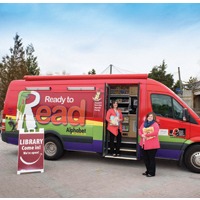
When the Toledo-Lucas County Public Library (TLCPL) set out to reassess its programs and staffing after state budget cuts in 2009, three significant facts led to the adoption of an early literacy program called Ready to Read:
- After the third grade, a child’s ability to learn is dependent on his or her reading skills.
- If a child starts kindergarten without the basic skills required to learn to read, it is virtually certain that he or she will not succeed in school thereafter.
- In the Toledo area, more than one third of children tested each year score below minimum kindergarten literacy readiness standards.
When you look at a group of third-graders’ reading scores and compare them to the same group’s kindergarten readiness scores from three years earlier, the breakdowns are virtually identical,” explained TLCPL’s Youth Services Coordinator, Nancy Eames. “That carries all the way through to graduation rates — and it has serious implications for our community.”
Assessing Needs, Creating Solutions
“Budget cuts at the state level in 2009 forced us to reconsider how we were utilizing our community outreach resources,” said TLCPL’s Development Coordinator Kathryn Fell. “Early literacy had been an ongoing focus for the library, but we wanted to do more. The Toledo Community Foundation helped us start that process through a capacity grant, which funded a new strategic plan for the Library Legacy Foundation. The Ready to Read program was an outcome of that planning.”
“The Ready to Read program is distinctive because the focus is on developing skills in parents and child-care providers — not on the children themselves,” said Nancy, who suggested the program to the strategic planning team. “Studies show that children need six basic skills to be ready to learn to read, which are developed largely through five types of interaction with a child’s primary caregivers (see sidebar at right). Ready to Read provides parents with resources to support these interactions, which in turn build foundational skills for reading.”
Two full-time librarians, Lauren Boeke and Cristin Brown, bring the TLCPL Ready to Read program to the community via a van filled with resources for parents and in-home child-care providers, including children’s books, how-to manuals — even GED prep courses.
A Community Funds grant from Toledo Community Foundation ensures that low-income parents who enroll in the program receive a Ready to Read kit, which includes books and other educational materials for children. The kit is key to the program because it is designed by library staff to equip parents to work with their children, engaging both in the five behaviors on which early literacy is built. “Parents are thrilled with the kit — and librarians can mentor parents in behaviors that lead to early literacy by demonstrating the kit’s components,” Nancy commented.
Critical to the success of Ready to Read are the librarians themselves. “The relationships our librarians build with parents and caregivers is one of the most important aspects of the program,” said Nancy. “And our librarians’ outreach to in-home child-care providers is bringing essential skills to a group largely without access to this kind of training and development.”
6 Skills
Early literacy skills that every child needs: 1. Phonemic awareness, 2. Vocabulary, 3. Print awareness: the recognition of print as a means of conveying information, 4. Print motivation: the love of books and understanding of the conventions of books (left to right, top to bottom, front to back, etc.), 5. Narrative skills, 6. Letter knowledge
Learn more!Sustained growth through strategic funding
To develop and sustain the Ready to Read program, TLCPL’s Library Legacy Foundation developed a two-prong capital campaign, called “Planting a Seed to Read”. The campaign plans to allot $1 million to programming, and another $1 million to fund a Ready to Read endowment.
One of the major Seed to Read donors was ProMedica, which committed $150,000 to the campaign through its Community Revitalization Fund with Toledo Community Foundation. ProMedica’s director of community relations, advocacy and grants, Stephanie Cihon, cited the Foundation’s vetting of the program and the community outreach component of Ready to Read as factors in ProMedica’s support. “We need a strong, literate workforce for a strong community,” said Stephanie. “Knowing the library was taking this program directly into neighborhoods where it was most needed was very important to us.”
With the initial goal of reaching 500 families achieved before even a full year had been completed, the next goal is to reach 1000 families annually. However, the Ready to Read team will not achieve its ultimate goal until EVERY child in Toledo is ready to read by kindergarten.
“We want to assure this program is here for the long run,” said Kathryn. “By creating an endowment for Ready to Read, we provide our donors a measure of assurance that the program will be sustained. We’ve enjoyed strong support from a broad range of community partners. Having the Toledo Community Foundation with us at the outset gave credibility to our vision, and encourages others to come forth with support.”
Boys & Girls Clubs of Toledo
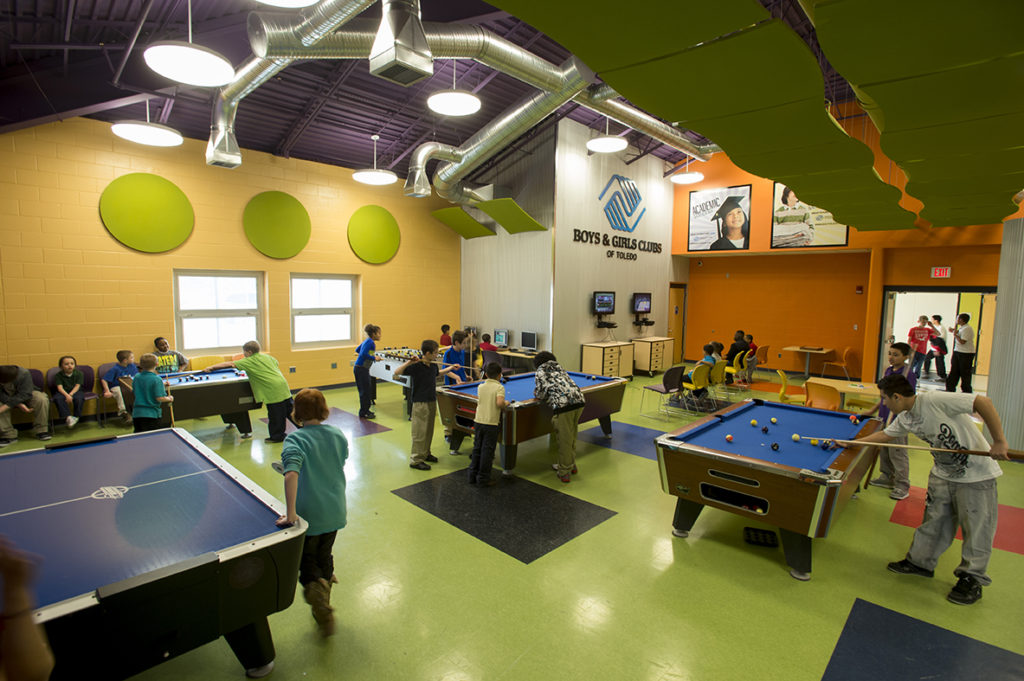
It all began with a Christmas dinner for 102 rough-and-tumble newsboys in 1892.
Realizing that those struggling boys needed much more than a holiday meal, John Gunckel solicited support from community leaders and went on to help thousands of area youngsters at what became the Boys & Girls Clubs of Toledo. Eighty years after that first generous act, the Clubs entered a new era of community partnership with support from the Toledo Community Foundation.
“The Boys & Girls Clubs of Toledo was among our very first grant recipients,” noted Foundation President, Keith Burwell. “Over the past 40 years, nearly a million Foundation dollars have supported the Clubs’ mission of helping kids reach their full potential.”
Continuing the legacy of business community leadership, founding TCF board member Sam Carson began the partnership between the Foundation and the Clubs. Carson family donor advised funds have supported capital improvements, helped establish the Clubs’ Goal Setters program, and assisted with college expenses for 30 Clubs’ alums. When the Clubs sought to expand their community partnerships in the mid 1990s, the Foundation again played a role.
Clubs and Toledo Public Schools: Better Together
“While developing new strategic initiatives, the Clubs’ governing board realized that Toledo Public Schools and our Clubs were the two oldest institutions serving kids in our city,” said Clubs’ Executive Director Dave Wehrmeister. “With the vision of then School Superintendent Eugene Sanders, we began our new full service Club in Sherman Elementary — and Carson family funds helped us establish a Club in Marshall Elementary.
“We now have three in-school Boys & Girls Clubs in neighborhoods where we’re needed most, supporting what kids are doing during classroom hours,” Wehrmeister noted. “Goal Setters and our Power Hour homework completion program not only help kids achieve, but also provide character-building experiences as older kids mentor the younger in a fun and caring environment. Toledo Community Foundation resources have done much to make this progress possible.”
New partnerships for even greater impact
In coming years, the Foundation will support organizations like the Boys & Girls Clubs in a significant new way. Aspire, a major strategic partnership to help Toledo’s children develop from cradle to career, brings together leaders of business, education and community groups in strategic collaborations much like that of the Clubs and Toledo Public Schools.
One such business leader is Al Stroucken, Chairman and CEO of global glass container maker Owens-Illinois, Inc. and Chair of the Aspire Board of Managers. “Aspire is using continuous improvement processes and data to drive accountability and results among the many initiatives already underway in the city. We believe we can help enhance the collective impact of the many groups at work on behalf of the children of Lucas County to bring long-lasting change.”
“The Foundation’s investment in our Clubs has paid real human dividends,” said Wehrmeister, noting that he himself was a former Boys & Girls Clubs member. “Ninety-six percent of our kids are on free or subsidized school lunches, and their family circumstances are often challenging — so there is much work yet to be done. We look forward to playing a role in Aspire as our relationship with the Foundation continues.”

Jenna Perez, 13, never thought spending a summer at the Catholic Club’s Summer Camp would open up an entirely new and exciting world for her.
“Because I couldn’t stay home alone, I had to go to the Catholic Club last summer. I would go there and just sleep and not talk to anyone. Then we went to the Toledo Ballet and even though I had not sung or danced before, it was so comfortable for me,” says the junior high school student.
Jenna participated in the Summer Musical Theater Program, collaboration between the Ballet and Catholic Club, funded by the Greater Toledo Community Foundation. The pilot program offered musical theater instructions to 13 boys and 13 girls. From this group, the ballet awarded three scholarships for dancers to continue lessons.
Because of her talent, Jenna was awarded a scholarship to take vocal and musical theater lessons. “I would have never had the opportunity to do this. Performing comes so naturally to me and it pushes me to work harder. It has helped me grow and now that I know what I’m doing, I’m no longer scared,” Jenna adds.
“This is just one of our programs where we work very hard to reach out to young people who may have never been exposed to dance. We don’t want dance to be exclusive but inclusive and this program helps break down barriers,” says Mari Davies, executive director of the Toledo Ballet Association.
Mari says with pride that “Jenna has such tremendous talent and interest. Her introduction to musical theater is a real success for our program and to her future no matter where her life takes her.”
Seeking A Grant
Visit www.toledocf.org for complete information about the Foundation’s grant making. For additional information, contact Senior Program Officer, Patrick Johnston at Greater Toledo Community Foundation, 419.241.5049.
Contact TCF
Since the Civil War, children have found an activity-filled place to get their little lives off to a good start at Toledo Day Nursery.
Operating from four locations in Toledo, the Nursery offers children of working and student parents quality, affordable childcare programs to help with educational, social, emotional and physical development.
Since 1998, the Toledo Community Foundation has given grants totaling more than $220,000 to the 138-year-old nursery to “sing and soothe” infants to five year olds.
“The Foundation has always been our friend and supports us in all our ventures. With them we are able to put smiles on children’s faces,” says Pat Scheuer, executive director.
Today some of the children are the third generation of their families to attend the nursery that offers a safe environment. Regardless of income, all children are welcome and everyone pays a fee to attend the nationally accredited program.
“We had a grandfather who brought his grandchild to the nursery and just smiled. He said he remembered the warmth he felt as a child going to the nursery as soon as he walked through the door,” says Pat who has directed the nursery for 10 years.
Receiving compliments from kindergarten teachers on how well Toledo Day Nursery school graduates are prepared makes for a highly successful program that is a positive reflection on the children and the community.
